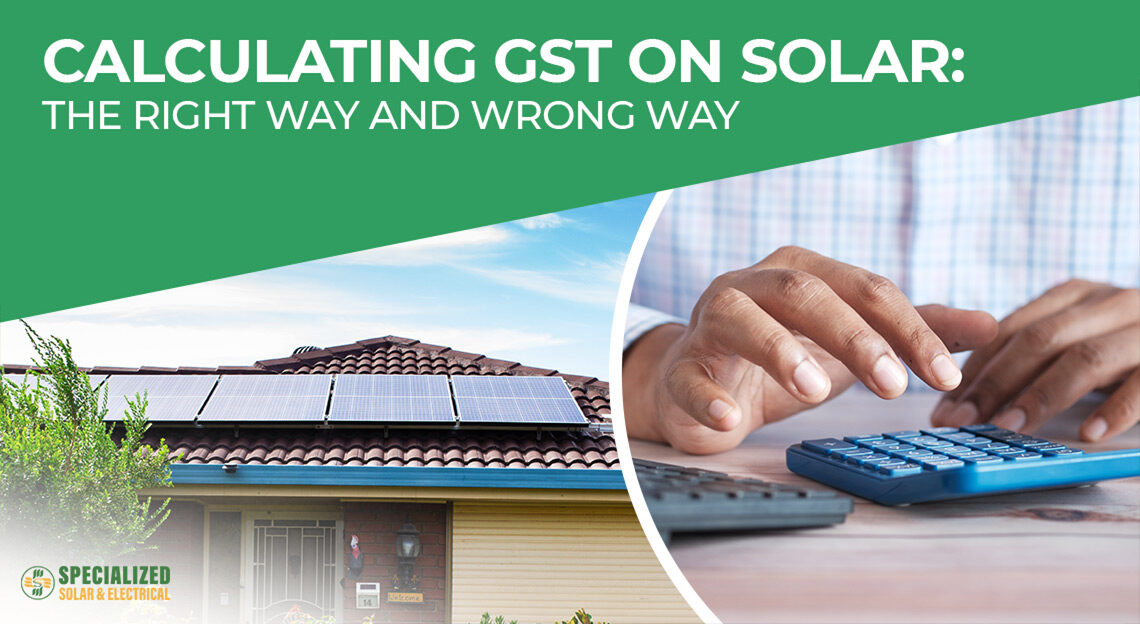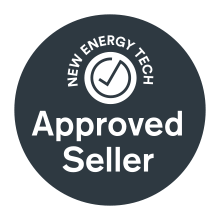There’s a right way and a wrong way to calculate GST on residential solar power (PV) systems. For various reasons, some solar companies are calculating GST in the wrong way. This is resulting in a massive underpayment of GST by Australian solar companies worth millions in unpaid taxes.
This is a ticking time bomb for the solar industry. Once the ATO catches up on those solar companies handling GST incorrectly, they’ll be landed with huge tax bills which they may not be able to pay. The result? The company folds – and Australian solar owners are left with unsupported solar panels systems and warranties that aren’t worth the paper they’re written on.
So, what’s going on?
This blog explains where the GST error is occurring on residential solar system sales – and how it should be done correctly. Also explained is the impact on the customer end price.
On this post:
- GST underpayment: the extent of the problem
- Why it’s a ticking time bomb
- The #1 issue: treatment of STCs
- Calculating GST on solar: the right way and the wrong way
- Implications of incorrect GST
GST underpayment: the extent of the problem
Solar retailers who calculate GST the wrong way are underpaying GST on every residential solar panel system they install.
The GST underpayment is around $280 on a typical 6.6kW solar panels system (note: 6.6kW is the average size residential solar system in 2022).
This might not sound like much, but it can quickly add up.
Take the example of a mid-size solar retailer who installs 15 systems a week. If they’re calculating GST in the wrong way, that’s a weekly GST underpayment of $4,200. Over 12 months that’s $210,600.
If this continues for 2 or 3 years before the ATO spots the underpayment, they could be landed with an unexpected tax bill of up to $604,800.
Why it’s a ticking time bomb
Given that most solar installers work on tight margins, chances are they won’t have the cash to pay the tax bill. Either they enter into a repayment arrangement with the ATO or liquidate the business.
Liquidation is the worst possible outcome for their customers; that’s because they end up with a solar system that’s no longer properly supported. Warranties such as the workmanship warranty and whole-of-system warranty would be wiped out. First line support for warranty claims on panels and inverters would disappear.
GST is a ticking time bomb not just for solar companies, but also their customers. If left unchecked, it has the potential to leave thousands of households with unsupported solar systems and tarnish the reputation of the whole industry.
The #1 mistake: the treatment of STCs
STCs, or Small-scale Technology Certificates, are a form of solar rebate from the Australian Government. They work as a point-of-sale discount reducing the customer sell price.
The issue with GST miscalculation stems from how STCs are treated.
The ATO website states that for residential solar panels systems, “GST should be calculated on the price of the installation before the discount (i.e. STCs) is applied.”
And this is where the error arises.
STCs are not part of the cost price of a solar panels system. STCs belong to the customer purchasing the solar PV system. It is the customer’s choice whether they assign their STCs for the system to their Solar Retailer. (Although it’s worth noting that most customers do assign their STCs to their solar retailer as it saves them having to trade them on the STC market).
Calculating GST on solar: right way and wrong way
Solar companies who handle GST incorrectly make the mistake of deducting the value of STCs from the cost price (this is mistake #1). Margin is then added (mistake #2) and then GST (mistake #3). This results in a GST underpayment.
What they should do is add their margin to the cost price to come up with a total. GST should be calculated on the total. Only then should STCs be deducted.
To make this point clear, we’ll use a worked example to explain where the mistakes are occurring. This example is for a solar panel system with a cost price of $8,340.
First, here’s the right way of calculating GST on this solar system.
| Right way | |
|---|---|
| Cost price | $8,340 |
| Margin (10%) | $834 |
| Cost + margin | $9,174 |
| GST (10%) | $917 |
| Total | $10,091 |
| Value of STCs (70 STCs at $36 per STC) |
$2,520 |
| Customer end price (including GST discount) | $7,571 |
Next, here’s the wrong way of calculating GST – with the mistakes highlighted.
| Wrong way | What’s wrong | |
|---|---|---|
| Cost price | $8,340 | |
| Value of STCs (70 STCs at $36 per STC) |
$2,520 | STCs should not be deducted at this point. |
| Total (cost minus STCs) | $5,820 | |
| Add margin (10%) | $582 | Margin should have been added before deducting STCs |
| Total (inc margin) | $6,402 | |
| GST (10%) | $640 | GST amount is less that it should be |
| Customer end price | $7,042 | Customer end price is wrong (too low) due to incorrect handling of GST and margin. |
Implications of incorrect GST
1. GST too low
GST should be calculated on cost + margin.
Because margin isn’t included when GST is calculated – and STCs are deducted – the GST amount is too low.
The GST shortfall is around $280 on a 6.6kW solar PV system.
2. Margin too low
If the solar company is working on percentage margins and they calculate the GST in the wrong way (as per above), their margin will be too low.
This may mean the company is not making enough profit to be self-sustaining in the long run.
3. Customer end price too low
With artificially low GST and margin, the customer end price is lower than it should be.
Whilst this may result in more sales in the short term, it isn’t a viable long-term strategy.
The customer benefits from a cheaper solar system. But they unwittingly run the risk that their system will be unsupported if the solar provider goes into liquidation.
What you need to watch out for
If you are buying solar, ask your Solar Retailer to provide a fully itemised quote showing total system price before GST. Ask them to show the GST amount and provide a price less GST.
You should also ask them to show the value of the STCs and the price after STCs have been deducted.
If your Solar Retailer doesn’t give you a quote itemising each of these key elements, ask them to redo the quote.
Here’s an example of what the quote should include.
| Example | |
|---|---|
| Total system price (before STCs and GST) | $10,000 |
| GST (10%) | $1,000 |
| Price less GST | $9,000 |
| STCs (No. of STCs x value of each STC) |
$3,000 |
| Price less STCs and GST | $6,000 |
| Value of any other rebates (e.g., Victorian Solar Homes rebate for solar panels) | $1,400 |
| Purchase price | $4,600 |
Get in touch
If you have any questions after reading this article, get in touch. Dealing with a reputable Solar Retailer is important as you want to be sure that they’ll be around for the long term to honour any warranties. Making sure you’ve got a Solar Retailer who’s doing the right thing is an investment in the longevity of your system.
At Specialized Solar & Electrical, we take pride in upholding the standards in the solar industry. We’re a fully Accredited Clean Energy Council Solar Retailer, Smart Energy Council Member and Registered Electrical Contractor.
We provide a minimum 10-year whole-of-system warranty (our performance guarantee) which is over and above the requirements set out by the Clean Energy Council. That’s because we want our customers to have the very best outcome from their solar investment – and the peace of mind knowing it will deliver the expected power output, no matter what.












